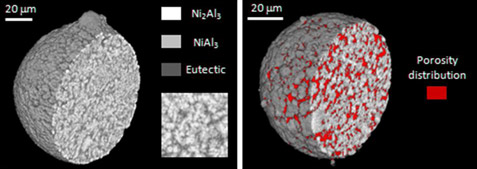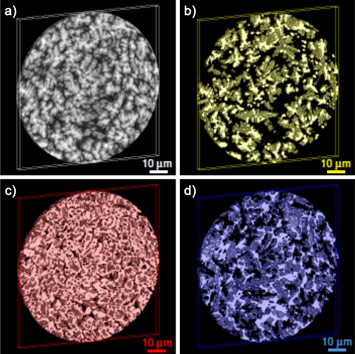- Home
- Industry
- Industry news
- Correlation of the...
Correlation of the microstructure of Raney-type nickel catalysts with catalytic performance
03-09-2010
Synchrotron X-ray microtomography was used to examine the microstructure of various Ni-Al alloys prepared by gas atomisation. A correlation between the microstructure and catalytic activity was identified. Using the results to help optimise the alloy composition, Raney-type nickel catalysts with activity far superior to standard commercial preparations were produced.
Share
The Challenge
The objective of this work was to develop more efficient and cheaper nickel catalyst powders, so called Raney-type nickel catalysts, for use in hydrogen fuel cell electrodes and hydrogenation reactions.
Background
The European Space Agency (ESA) together with the ILL (neutron source) and the ESRF formed a collaboration [1] to investigate the link between the process of solidification in intermetallic alloys, their structure at both microscopic and nanoscopic levels, and their final mechanical, physical and chemical properties. Raney nickel catalysts are traditionally prepared by taking a cast-and-crush manufactured Ni-Al alloy and leaching out the Al using concentrated sodium hydroxide solution. The remaining nickel has a porous structure and is both pyrophoric and highly reactive. In the present study, gas atomisation, an alternative method of manufacture, was used to prepare alloys of various Ni-Al compositions in the form of spherical particles, which were then activated by leaching to form the catalyst.
Synchrotron techniques
Extensive characterisation of the precursor alloys and the “spongy nickel” catalysts was made using synchrotron techniques including X-ray photoelectron spectroscopy, X-ray nanotomography, as well as other complementary techniques such as neutron diffraction, Hg intrusion and N2 adsorption, atomic resolution He-ion and electron microscopy.
Results
Visualisation of the microstructure of the alloys permitted an understanding of the structural features contributing to catalytic activity. The precursor alloys contained a mixture of different phases: Ni2Al3, NiAl3 and metallic Al. For an alloy with the optimum composition, an extensive dendritic network was evident within the precursor alloy and this was also preserved within the catalyst after the leaching process (Figure 1).
 |
| Figure 1. Microtomography 3D reconstructions showing (a) distribution of alloy phases within a Ni-Al atomised droplet; and (b) pore distribution within a passivated Raney-type Ni droplet. These studies were carried out at beamline ID19 (Courtesy G. Reinhart, ESA). |
A model was proposed correlating the microstructure of the precursor alloy and the catalytic performance of the catalyst. The dendritic network is formed from Ni2Al3 which is the first phase to solidify from the melt, later being covered by other phases (Figure 2). Ni2Al3 is also the phase most resistant to etching, which explains the presence of the network in the etched catalyst, supporting a capping layer of almost pure Ni.
 |
| Figure 2. Nanotomography images of 1.2 µm thick cylindrical cross sections of activated catalysts showing (a) the inner microstructure of a Ni-77.5at%Al droplet, (b-d) 3D distribution of the Ni2Al3, NiAl3, and eutectic phases respectively. Studies carried out at beamline ID22 (Courtesy G. Reinhart, ESA). |
Overall, a cost-effective gas atomisation and leaching process for commercial sponge nickel catalyst production was developed. Notable results include new precursor Ni-Al-X alloy compositions with specialised dopants and doped spongy Ni catalysts with 10 times better catalytic activity than standard commercial preparations for various industrially important chemical reactions.
How did the synchrotron experiment help?
The structural hierarchy of the catalysts was investigated across six orders of magnitude. X-ray microtomography provided the phase composition of the precursor alloys, and permitted visualisation of the macroporous network of the catalyst in 3D reconstructions.
Further information
Synchrotron X-ray microtomography of Raney-type nickel catalysts prepared by gas atomisation: Effect of microstructure on catalytic performance, F. Devred, G. Reinhart, G.N. Iles, B. van der Klugt, N.J. Adkins, J.W. Bakker and B.E. Nieuwenhuys, Catalysis Today, (2010), in press., doi:10.1016/j.cattod.2010.01.054.
Acknowledgements
We thank G. Iles and G. Reinhart, ESA, for their help in preparing this document.
References
[1] IMPRESS: Intermetallic Materials Processing in Relation to Earth and Space Solidification. Website: www.spaceflight.esa.int/impress
Top image: X-ray microtomography was used to identifty the phase composition of the precursor alloys.



